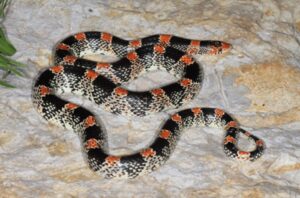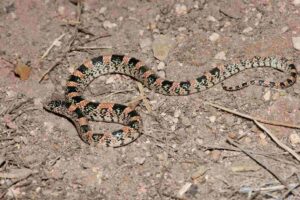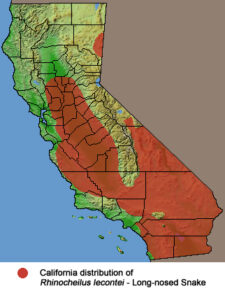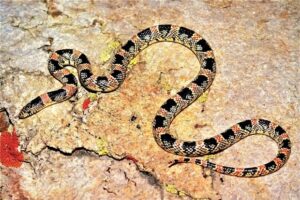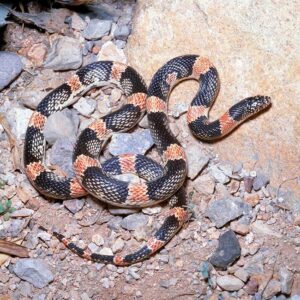The long-nosed or longnose snake is a colubrid endemic to North America. The specific name lecontei is in honor of American entomologist John Lawrence Le Conte (1825-1883). It can be uniquely identified by its long, pointed snout. It is active from mid-May through early September though weather conditions could result in a longer season.
Scientific Classifications
- Suborder:Serpentes
- Family:Colubridae
- Genus:Rhinocheilus
- Species:R. lecontei
Conservation Status
Subspecies
This snake has two recognized subspecies.
- Western long-nosed snake (Rhinocheilus lecontei lecontei)
- Texas long-nosed snake (Rhinocheilus lecontei tessellatus)
Description
Size
The adults have a total size of 22-32 in (56-81 cm), including the tail. The maximum recorded total length is 41 in (100 cm).
Color and Appearance
A distinguishing feature of the long-nosed snake is its slightly upturned snout. Hence its common name. There are 3 colors on its body with red and black saddling on a cream or yellow colored background. The pattern of cream-colored spots inside the black saddles is unique to the species. The white belly can have occasional dark spots.
Its undivided subcaudal scales make it different from all other harmless snakes in the United States. The slender snake has smooth scales and a head barely wider than the body.
Are They Dangerous to Humans
The long-nosed snake almost never bites, even with extreme provocation. But it releases blood and foul-smelling musk from its cloaca as a defense measure when harassed. It can also vibrate its tail and writhe its body at that time.
Long-nosed Snakes at a Glance
Distribution
In northern Mexico, its range extends from San Luis Potosí to Chihuahua, into the southwestern United States, in Nevada, California, Utah, Arizona, Idaho, New Mexico, southwestern Kansas, southeastern Colorado, Texas, and Oklahoma.
Habitat
It prefers deserts, shrublands, grasslands, and savannas. The shy, nocturnal, fossorial snake is buried underground most of the time.
Lifespan
The long-nosed snake lives for 10-19 years.
Predators
It is eaten by predatory mammals and birds.
Diet
The colubrid eats amphibians, lizards, sometimes smaller snakes, and seldom rodents.
Reproduction
Oviparous (lays eggs that hatch outside the body)
The long-nosed snake lays clutches of 4-9 eggs in early summer. They hatch in late summer or early fall.
Care Sheet
Long-nosed snakes are notorious escape artists and are pretty difficult to keep due to their rejection of a rodent-based diet that is readily available for pet snakes.
Size of the Enclosure: The terrarium should be the same length as that of the snake. It is best to keep a single snake in a cage.
Temperature: The daytime temperature should be around 80°F and never exceed 90°F. It can fall to no lower than 70°F at night.
Humidity: There is no set humidity level for the pet. Light misting is all you need to maintain humidity in the enclosure. A small bowl of clean water should be placed in the tank to prevent the humidity from rising to high levels.
Substrate: Loose sand of about 2 inches of thickness is suitable as the substrate. Newspaper is also a good option.
Feeding: The pets can be fed skinks, anoles, fence lizards, and other easily available lizard species. They can also be fed mice having the scent of lizards.
Source
researchgate.net, media.kidadl.com, californiaherps.com, reptilescove.com, monaconatureencyclopedia.com

